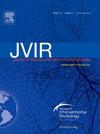Multicenter Analysis of RENAL, mRENAL, and (MC)2 Scoring Systems as Predictors of Outcomes after Percutaneous Cryoablation of Renal Cell Carcinoma
IF 2.6
3区 医学
Q2 PERIPHERAL VASCULAR DISEASE
Journal of Vascular and Interventional Radiology
Pub Date : 2025-04-18
DOI:10.1016/j.jvir.2025.04.008
引用次数: 0
Abstract
Purpose
To compare the performance of the RENAL, mRENAL, and (MC)2 scores in predicting outcomes after cryoablation of renal cell carcinoma.
Materials and Methods
Retrospective chart review was performed for patients who underwent cryoablation within a hospital system between 2018 and 2023. A total of 103 cryoablation procedures in 103 patients were included. Medical history, demographic information, preprocedural imaging, tumor characteristics, periprocedural hospital course, postprocedural adverse events, and follow-up imaging results were reviewed. Each tumor was assigned a RENAL, mRENAL, and (MC)2 score and categorized into a low, medium, or high group for each scoring system.
Results
Twenty-one patients (20.5%) developed Society of Interventional Radiology (SIR) graded adverse events. Severe adverse events occurred in 9 patients (8.7%). High RENAL (P = .003), mRENAL (P = .047), and (MC)2 (P = .004) scores were associated with a significant increase in the risk of severe postprocedural adverse events. All 3 scoring systems were equivalent in their ability to predict severe adverse events. Higher RENAL (P = .018 and P = .019) and mRENAL (P = .007 and P = .005) but not (MC)2 scores were associated with increased likelihood of unplanned hospital admission and longer hospital length of stay (LOS). RENAL, mRENAL, and (MC)2 scores were not significantly associated with primary technique effectiveness.
Conclusions
The RENAL, mRENAL, and (MC)2 scores performed equally in predicting severe adverse events after cryoablation. The RENAL and mRENAL scores predicted postprocedural hospital admission and hospital LOS more effectively than (MC)2. The scoring systems were not predictive of primary technique effectiveness despite a trend toward lower effectiveness in tumors with higher scores.

肾、肾和(MC)2评分系统作为肾细胞癌经皮冷冻消融后预后预测因子的多中心分析
目的:本研究比较肾、mRENAL和(MC)2评分在预测肾细胞癌冷冻消融后预后方面的表现。材料和方法:回顾性分析2018年至2023年在某医院系统内接受冷冻消融治疗的患者。纳入103例患者的103例冷冻消融手术。回顾病史、人口统计信息、术前影像学、肿瘤特征、术中住院过程、术后不良事件和随访影像学结果。每个肿瘤被赋予肾、肾和(MC)2评分,并根据每个评分系统分为低、中、高组。结果:21例患者(20.5%)出现SIR分级不良事件。严重不良事件9例(8.7%)。高肾(p = 0.003)、mRENAL (p = 0.047)和(MC)2 (p = 0.004)评分均与严重术后不良事件的风险显著增加相关。所有三种评分系统在预测严重不良事件的能力上是相同的。较高的RENAL (p = 0.018, 0.019)和mRENAL (p = 0.007, 0.005)评分与计划外住院的可能性增加和住院时间延长相关,但不与(MC)2评分相关。RENAL、mRENAL和(MC)2评分与主要技术有效性无显著相关。结论:RENAL、mRENAL和(MC)2评分在预测冷冻消融后严重不良事件方面具有相同的效果。RENAL和mRENAL评分比(MC)更有效地预测术后住院率和住院LOS 2。评分系统不能预测主要技术的有效性,尽管在得分较高的肿瘤中有降低有效性的趋势。
本文章由计算机程序翻译,如有差异,请以英文原文为准。
求助全文
约1分钟内获得全文
求助全文
来源期刊
CiteScore
4.30
自引率
10.30%
发文量
942
审稿时长
90 days
期刊介绍:
JVIR, published continuously since 1990, is an international, monthly peer-reviewed interventional radiology journal. As the official journal of the Society of Interventional Radiology, JVIR is the peer-reviewed journal of choice for interventional radiologists, radiologists, cardiologists, vascular surgeons, neurosurgeons, and other clinicians who seek current and reliable information on every aspect of vascular and interventional radiology. Each issue of JVIR covers critical and cutting-edge medical minimally invasive, clinical, basic research, radiological, pathological, and socioeconomic issues of importance to the field.

 求助内容:
求助内容: 应助结果提醒方式:
应助结果提醒方式:


